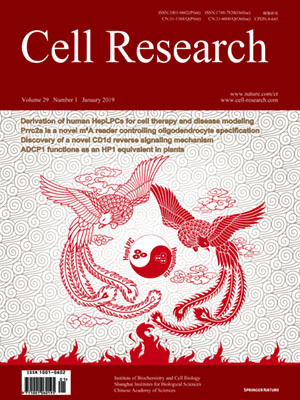
Volume 29, No 1, Jan 2019
ISSN: 1001-0602
EISSN: 1748-7838 2018
impact factor 17.848*
(Clarivate Analytics, 2019)
Volume 29 Issue 1, January 2019: 8-22 | Open Access
ORIGINAL ARTICLES
Expansion and differentiation of human hepatocyte-derived liver progenitor-like cells and their use for the study of hepatotropic pathogens
Gong-Bo Fu 1, Wei-Jian Huang 1, Min Zeng 1, Xu Zhou 1, Hong-Ping Wu 2, Chang-Cheng Liu 3, Han Wu 1, Jun Weng 4, Hong-Dan Zhang 5,Yong-Chao Cai 3, Charles Ashton 6, Min Ding 7, Dan Tang 8, Bao-Hua Zhang 2, Yi Gao 4, Wei-Feng Yu 8, Bo Zhai 7, Zhi-Ying He 3,
Hong-Yang Wang 1,2 and He-Xin Yan 1,2,7,8
1International Cooperation Laboratory on Signal Transduction, Eastern Hepatobiliary Surgery Hospital, Second Military Medical University, Shanghai, China; 2National Center for Liver Cancer, Shanghai, China; 3Institute for Regenerative Medicine, Shanghai East Hospital, School of Life Sciences and Technology, Tongji University, Shanghai, China; 4Department of Hepatobiliary Surgery II, Zhujiang Hospital, Southern Medical University, Guangzhou, China; 5Celliver Biotechnology Inc., Shanghai, China; 6Zilkha Neurogenetic Institute, University of Southern California, Los Angeles, CA, USA; 7Department of Interventional Oncology, Renji Hospital, Jiaotong University School of Medicine, Shanghai, China and 8Department of Anesthesiology and Critical Care Medicine, Renji Hospital, Jiaotong University School of Medicine, Shanghai, China
Correspondence: Bo Zhai (zhaiboshi@sina.com) or Zhi-Ying He (zhiyinghe2002@163.com) or Hong-Yang Wang (hywangk@vip.sina.com) or He-Xin Yan (hexinyw@163.com)These authors contributed equally: Gong-Bo Fu, Wei-Jian Huang, Min Zeng, Xu Zhou, Hong-Ping Wu.
The study of pathophysiological mechanisms in human liver disease has been constrained by the inability to expand primary hepatocytes in vitro while maintaining proliferative capacity and metabolic function. We and others have previously shown that mouse mature hepatocytes can be converted to liver progenitor-like cells in vitro with defined chemical factors. Here we describe a protocol achieving efficient conversion of human primary hepatocytes into liver progenitor-like cells (HepLPCs) through delivery of developmentally relevant cues, including NAD + -dependent deacetylase SIRT1 signaling. These HepLPCs could be expanded significantly during in vitro passage. The expanded cells can readily be converted back into metabolically functional hepatocytes in vitro and upon transplantation in vivo. Under three-dimensional culture conditions, differentiated cells generated from HepLPCs regained the ability to support infection or reactivation of hepatitis B virus (HBV). Our work demonstrates the utility of the conversion between hepatocyte and liver progenitor-like cells for studying HBV biology and antiviral therapies. These findings will facilitate the study of liver diseases and regenerative medicine.
https://doi.org/10.1038/s41422-018-0103-x
FULL TEXT | PDF
Browse 1400


